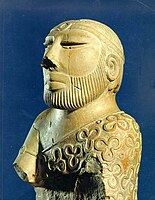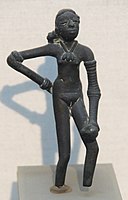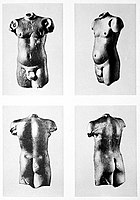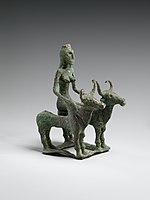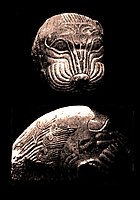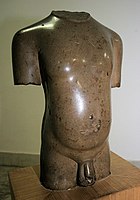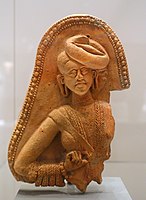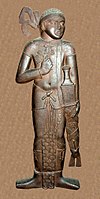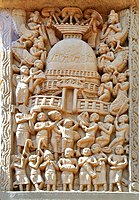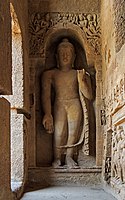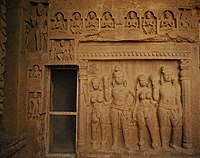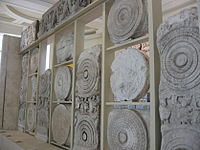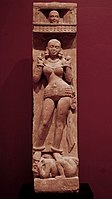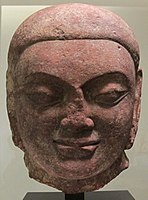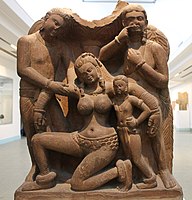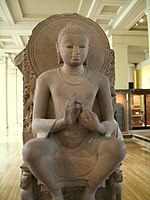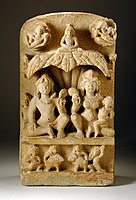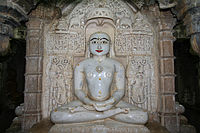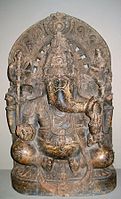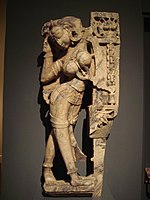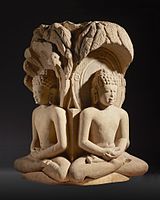Sculpture in the Indian subcontinent
| Art forms of India |
|---|
 |
Sculpture in the Indian subcontinent, partly because of the climate of the Indian subcontinent makes the long-term survival of organic materials difficult, essentially consists of sculpture of stone, metal or terracotta. It is clear there was a great deal of painting, and sculpture in wood and ivory, during these periods, but there are only a few survivals. The main Indian religions had all, after hesitant starts, developed the use of religious sculpture by around the start of the Common Era, and the use of stone was becoming increasingly widespread.
The first known sculpture in the Indian subcontinent is from the
During the 2nd to 1st century BCE in far northern India, in the Greco-Buddhist art of Gandhara from what is now southern Afghanistan and northern Pakistan, sculptures became more explicit, representing episodes of the Buddha's life and teachings.
The pink sandstone Hindu,
Bronze age sculpture
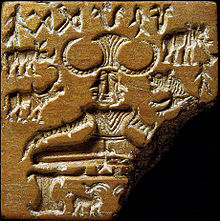
The first known sculpture in the Indian subcontinent is from the
-
The Priest-King, Mohenjo-daro
-
Dancing Girl, Mohenjo-daro
-
Harappan jasper torso
-
The second Dancing Girl bronze figure
-
Daimabad Chariot
-
Woman riding two bulls (bronze), from Kausambi, c. 2000-1750 BCE
Pre-Mauryan art
Some very early depictions of deities seem to appear in the art of the
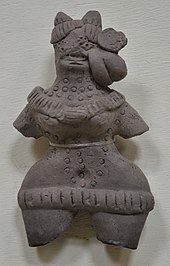
Various artefacts may belong to the
Most of the early finds following this period correspond to what is called the "second period of urbanization" in the middle of the 1st millennium BCE, after a gap about a thousand years following the collapse of the
Art of the Mauryan period (322-185 BCE)
The surviving art of the
The most significant remains of monumental Mauryan art include the remains of the royal palace and the city of
This period marked the appearance of Indian stone sculpture; much previous sculpture was probably in wood and has not survived. The elaborately carved animal capitals surviving on from some
The highly polished surface of court sculpture is often called Mauryan polish. However this seems not to be entirely reliable as a diagnostic tool for a Mauryan date, as some works from considerably later periods also have it. The Didarganj Yakshi, now most often thought to be from the 2nd century CE, is an example.
-
The Pataliputra capital, showing both Achaemenid and Greek influence, with volute, bead and reel, meander and honeysuckle designs. Early Mauryan period, 4th-3rd century BC.
-
Masarh lion sculpture
-
Mauryan statue 3rd-2nd century BCE
-
Yaksha statue
-
Didarganj Yakshi with fly-whisk (chauri) is held in the right hand whereas the left hand is broken, in the Bihar Museum
Art of the Shunga period (180-80 BCE)
Terracotta arts executed during pre-Mauryan and Mauryan periods are further refined during Shunga periods and Chandraketugarh emerge as an important center for the terracotta arts of Shunga period. Mathura which has its basis in the pre-Mauryan period also emerges as an important center for Jain, Hindu and Buddhist art.
-
Bharhut stupa, Shunga horseman
-
Shunga Yakshi
-
Chandraketugarh figurine
-
Male figure, Chandraketugarh, India, 2nd-1st century BCE
-
Bharhut Yavana(Greek) Warrior
Satavahana art
The
Sanchi stupas were constructed by
-
Sanchi gateway
-
Carved reliefs of Sanchi gateway
-
Satavahana relief regarding the city of Kusinagara in the war over the Buddha's relics, South Gate, Stupa no. 1, Sanchi
-
Bimbisara with his royal cortege issuing from the city of Rajagriha to visit the Buddha.
-
Foreigners making a dedication to the Great Stupa at Sanchi.
Cave temples
Between the 2nd century BCE and 2nd century CE under Satavahanas, several Buddhist caves propped up along the coastal areas of Maharashtra and these cave temples were decorated with Satavahana era sculptures and hence not only some of the earliest art depictions, but evidence of ancient Indian architecture.
-
Kanheri cavesBuddha statue
-
Kanheri caves statue
Amaravati art
The Amaravati school of Buddhist art was one of the three major Buddhist sculpture centres along with Mathura and Gandhara and flourished under Satavahanas, many limestone sculptures and tablets which once were plastered Buddhist stupas provide a fascinating insight into major early Buddhist school of arts.
-
Amaravati Marbles, fragments of Buddhist stupa
-
Head of a lion, from Gateway pillar at the Amaravati Stupa
-
Scroll supported by IndianAmaravati, 2nd–3rd century CE
-
Mara's assault on the Buddha, 2nd century CE, Amaravati
Early South India
Stone sculpture was much later to arrive in South India than the north, and the earliest period is only represented by the
Though the hardness of local granites, the relatively limited penetration of Buddhism and Jainism in the deep south, and a presumed persistent preference for wood have all been proposed as factors in the late development of stone architecture and sculpture in the south, "the mystery remains".[21] The form of the Gudimallam Lingam, for example, would be a natural one to evolve in wood, using a straight tree trunk very efficiently, but to say that it did so is pure speculation in our present state of knowledge. Wooden sculpture, and architecture, has remained common in Kerala, where stone is hard to come by, but this means survivals are very largely limited to the last few centuries.[22]
Kushana art
("Year 4 of the Great King Kanishka")
Kushan art is highlighted by the appearance of extensive Buddhist arts in the form of Mathuras, Gandharan and Amaravathi schools of art.
Mathura art
-
Spotted red sandstone Bodhisattwa, Mathura Art, Kushan Empire, 2nd century CE
-
Yakshi Mathura
-
Sibijataka and other Buddhist legends, Mathura art, 2nd century CE
-
Bhutesvara Yakshis, reliefs from Mathura, 2nd century CE
-
Tirthankara Head, Kushan Period, Mathura
-
Bacchanalianscene. Mathura
Gandharan art
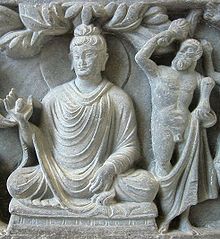
Although India had a long sculptural tradition and a mastery of rich iconography, the Buddha was never represented in human form before this time, but only through some of his symbols.
The origins of Greco-Buddhist art are to be found in the Hellenistic
-
Gandhara frieze with devotees, holding
-
Gandhara Poseidon (Ancient Orient Museum)
-
Taller Buddha of Bamiyan, c. 547 AD., in 1963 and in 2008 after they were dynamited and destroyed in March 2001 by the Taliban
Gupta art (319-510)

It is customary to include under "Gupta art" works from areas in north and central India that were not actually under Gupta control, in particular art produced under the

Both Buddhist and Hindu sculpture concentrate on large, often near life-size, figures of the major deities, respectively
The lingam was the central murti in most temples. Some new figures appear, including personifications of the Ganges and Yamuna rivers, not yet worshipped, but placed on either side of entrances; these were "the two great rivers encompassing the Gupta heartland".[39] The main bodhisattva appear prominently in sculpture for the first time,[40] as in the paintings at Ajanta. Buddhist, Hindu and Jain sculpture all show the same style,[41] and there is a "growing likeness of form" between figures from the different religions, which continued after the Gupta period.[32]
The Indian stylistic tradition of representing the body as a series of "smooth, very simplified planes" is continued, though poses, especially in the many standing figures, are subtly tilted and varied, in contrast to the "columnar rigidity" of earlier figures.[42] The detail of facial parts, hair, headgear, jewellery and the haloes behind figures are carved very precisely, giving a pleasing contrast with the emphasis on broad swelling masses in the body.[43] Deities of all the religions are shown in a calm and majestic meditative style; "perhaps it is this all-pervading inwardness that accounts for the unequalled Gupta and post-Gupta ability to communicate higher spiritual states".[32]
-
Buddha from Sarnath, 5–6th century CE
-
TheDharmachakra Pravartana Buddha at Sarnath, a Gupta statue of the Buddha from Sarnath, Uttar Pradesh, India, last quarter of the 5th century CE.
-
Terracotta Ganges and attendant; 1.47 metres, from Ahichchhatra, 5th-6th century CE
Early Medieval (600-1192-1206) onwards
Pala and Sena empires
The
Though the Pala monarchs are recorded as patronizing religious establishments in a general sense, their patronage of any specific work of art cannot be documented by the surviving evidence, which is mostly inscriptions.[45] However, there are much larger numbers of images that are dated, as compared to other Indian regions and periods, helping greatly the reconstruction of stylistic development.[46]
Much larger numbers of smaller bronze groups of similar composition have survived than from previous periods. Probably the numbers produced were increasing. These were mostly made for domestic shrines of the well-off, and from monasteries. Gradually, Hindu figures come to outnumber Buddhist ones, reflecting the terminal decline of Indian Buddhism, even in east India, its last stronghold.[47]
Temples of Khajuraho

The
The temples have a rich display of intricately carved sculptures. While they are famous for their erotic sculptures, sexual themes cover less than a tenth of the temple sculpture. The sculptures depict various aspects the everyday life, mythical stories as well as symbolic display of various secular and spiritual values important in Hindu tradition.[48]
Dynasties of South India
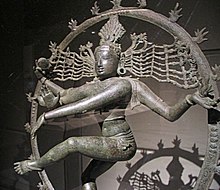
After the
Other Pallava temples with sculpture surviving in good condition are the

The "imperial" Chola dynasty begins about 850, controlling much of the south, with a slow decline from about 1150. Large numbers of temples were constructed, which mostly suffered far less from Muslim destruction than those further north. These were heavily decorated with stone relief sculpture, both large narrative panels and single figures, mostly in niches on the outside. The Pallava style was broadly continued.
Chola bronzes, the largest mostly about half life-size, are some of the most iconic and famous sculptures of India, using a similar elegant but powerful style to the stone pieces. They were created using the lost wax technique. The sculptures were of Shiva in various avatars with his consort Parvati, and Vishnu with his consort Lakshmi, among other deities.[53] Even large bronzes had the advantage that they were light enough to be used in processions for festivals.
The most iconic among these is the bronze figure of Shiva as Nataraja, the lord of dance. In his upper right hand he holds the damaru, the drum of creation.[54] In his upper left hand he holds the agni, the flame of destruction. His lower right hand is lifted in the gesture of the abhaya mudra. His right foot stands upon the demon Apasmara, the embodiment of ignorance.[55]
The Vijayanagara Empire was the last major Hindu empire, constructing very large temples at Hampi, the capital, of which much remains in generally good condition, despite the Mughal army spending a year destroying the city after its fall.[56] Temples are often highly decorated, in a style that further elaborates the late Chola style, and was influential for later South Indian temples. Rows of horses rearing out from columns became a favourite and spectacular device. By the end of the period hugely expanded multi-storey gopurams had become the most prominent feature of templeas, as they have remained in the major temples of the south. The large numbers of figures on these were now mostly made from brightly painted stucco.
Late Medieval period or Islamic rule (1206-1757)
The period was dominated by Islamic rulers, who not only did not produce figurative sculpture themselves, but whose armies, especially in the initial conquests, destroyed vast amounts of existing religious sculpture, which considerably discouraged the production of new figures.
Nonetheless, religious sculpture continued, especially in the far south, where the larger temples continued to expand in a rather competitive fashion. The late medieval southern innovation of towering gopuram gateways continued, and these were covered with large sculptures, in recent centuries mainly in brightly painted stucco. Very large halls were constructed for the large numbers of visitors in temples, sometimes filled with spectacular sculpture, like the famous row of life-size rearing horses at the Ranganathaswamy Temple, Srirangam from the 17th century.
British Colonial period (1757-1858-1947)
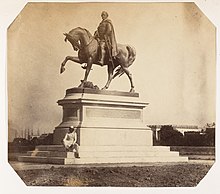
During this period, European styled statues were erected in city squares, as monuments to the British Empire's power. Statues of Queen Victoria, George V, and various Governor-Generals of India were erected. Such statues were removed from public places after independence, and placed within museums. However, some still stand at their original location, such as Statue of Queen Victoria, Bangalore.
Post-independence (1947 - present)
Modern Indian sculptors include D.P Roy Choudhury, Ramkinkar Baij, Pilloo Pochkhanawala, Mrinalini Mukherjee, Adi Davierwala, Sankho Chaudhuri and Chintamoni Kar.[57] The National Gallery of modern Art has a large collection of modern Indian sculpture.[57] Contemporary Indian sculptors include Sudarshan Shetty, Ranjini Shettar, Anita Dube and Rajeshree Goody.
Gallery
-
Jain chaumukha sculpture, 1st century CE
-
'A Jain Family Group' sculpture, Los Angeles County Museum of Art, 6th century
-
Shiva panel,Ellora.
-
13th century Ganesha statue
-
Stone Inscription at ASI Museum, Amaravathi
-
Secular scenes
-
Statue of Suparshvanatha from c. 900 C.E.
-
Seated Ganesha, sandstone sculpture from Rajasthan, 9th century
-
Kailasha Temple at Ellora Cave
-
Marble Sculpture of femaleyakshi in typical curving pose, c. 1450, Rajasthan
-
Jain tirthankara, Kushan Empire, 1st-2nd century
-
The iconic 57 ft high monolithic Statue of Gommateshwara, Shravanabelagola, 10th Century
See also
| Part of a series on the |
| Culture of India |
|---|
 |
Notes
- ^ Blurton, 22
- ^ Harle, 17–20
- ^ Harle, 22–24
- ^ a b Harle, 26–38
- ^ Harle, 87; his Part 2 covers the period
- ^ Harle, 124
- ^ Harle, 301-310, 325-327
- ^ "Group of Monuments at Mahabalipuram". UNESCO World Heritage Centre. Retrieved 2019-02-20.
- ^ Harle, 276–284
- ^ "South Asian arts - Visual arts of India and Sri Lanka (Ceylon)". Encyclopedia Britannica. Retrieved 2019-02-20.
- ^ JSTOR 29756891.
- JSTOR 29756891.
- ^ ISBN 978-0-470-75196-1.
- JSTOR 3248779.
- ISBN 81-219-0887-6, p.348
- ISBN 0-19-564445-X, pp.267-70
- ^ ISBN 9789004155374.
- ^ Harle, 28, 32-38
- ^ a b c Harle, 271
- ISBN 9780199593347.
- ^ Harle, 271-272, 272 quoted
- ^ Harle, 342-350; Blurton, 225
- ^ "Seated Buddha with Two Attendants". www.kimbellart.org. Kimbell Art Museum.
- ISBN 9789810567057.
- .
- ISBN 978-0-691-21747-5.
- ^ Boardman, 370–378; Harle, 71–84
- ^ Dehejia, Vidya. "Buddhism and Buddhist Art". Metropolitan Museum of Art. Retrieved 2019-02-20.
- ^ Boardman, 370–378; Sickman, 85–90; Paine, 29–30
- ^ Rowland's chapter 15 is called "The Golden Age: The Gupta Period; Harle, 88
- ^ Harle, 118
- ^ a b c Harle, 89
- ^ Rowland, 215
- ^ Harle, 199
- ^ Mookerji, 1, 143
- ^ Harle, 89; Rowland, 216; Mookerji, 143
- ^ Harle, 87–88
- ^ Rowland, 234
- ^ Harle, 87–88, 88 quoted
- ^ Rowland, 235
- ^ Rowland, 232
- ^ Rowland, 233
- ^ Rowland, 230–233, 232 and 233 quoted
- ^ Harle, 212-216; Craven, 170, 172-176; Huntington, generally, and p. 29 on freer attendants.
- ^ Huntington, 31 note 27 (the situation is little different for Gupta monarchs).
- ^ Huntington, 37, and Chapter 3 generally
- ^ Harle, 212; Craven, 176
- ^ a b c "Khajuraho Group of Monuments". UNESCO World Heritage Centre. Archived from the original on 2019-02-14. Retrieved 2019-02-20.
- ^ Harle, 272
- ^ Michell, 434-437
- ^ Harle, 277-278
- ^ Harle, 276-277
- ^ "Great Living Chola Temples". UNESCO World Heritage Centre. Archived from the original on 2018-12-26. Retrieved 2019-02-21.
- )
- ^ "Shiva as Lord of Dance (Nataraja)". Metropolitan Museum of Art. Retrieved 2019-02-20.
- ^ Rowland, 317
- ^ a b "Modern Sculptures". National Gallery of Modern Art, New Delhi. Retrieved 2019-02-14.
References
- Blurton, T. Richard, Hindu Art, 1994, British Museum Press, ISBN 0 7141 1442 1
- ISBN 0198143869
- ISBN 0500201463
- Harle, J. C., The Art and Architecture of the Indian Subcontinent, 2nd edn. 1994, Yale University Press. (ISBN 0300062176
- Huntington, Susan L. (1984). The "Påala-Sena" Schools of Sculpture. Brill Archive. ISBN 90-04-06856-2.
- Michell, George, The Penguin Guide to the Monuments of India, Volume 1: Buddhist, Jain, Hindu, 1990, Penguin Books, ISBN 0140081445
- Mookerji, Radhakumud (1997), The Gupta Empire, Motilal Banarsidass Publ., ISBN 9788120804401, google books
- ISBN 0140561080
- Rowland, Benjamin, The Art and Architecture of India: Buddhist, Hindu, Jain, 1967 (3rd edn.), Pelican History of Art, Penguin, ISBN 0140561021
- Sickman, Laurence, in: Sickman L & Soper A, The Art and Architecture of China, (Pelican History of Art), 3rd ed 1971, Penguin (now Yale History of Art), LOC 70-125675
Further reading
- Lerner, Martin (1984). The flame and the lotus: Indian and Southeast Asian art from the Kronos collections. New York: The Metropolitan Museum of Art. ISBN 978-0870993749. Retrieved 2016-03-06.
- Welch, Stuart Cary (1985). India: art and culture, 1300-1900. New York: The Metropolitan Museum of Art. ISBN 9780944142134.

